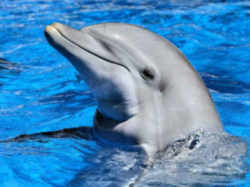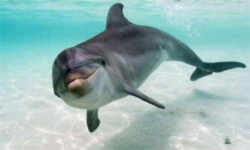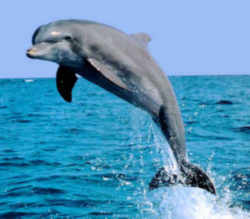
South Carolina Symbols
South Carolina State Marine Mammal
Bottlenose Dolphin

(Tursiops truncatus)
Adopted on June 3, 2009
The Bottlenose Dolphin, (Tursiops truncatus,) was designated as the official State Marine Mammal by Act Number 58 of 2009. Bottlenose dolphins are found worldwide in temperate and tropical waters. An adult is usually 8 to 12 feet in length and can weigh up to 1430 pounds. They tend to be one of the most recognizable marine mammals due to their widespread use in marine parks and research facilities. The bottlenose dolphin is protected in U.S. waters under the Marine Mammal Protection Act.
The terms porpoise and dolphin are often used interchangeably. Usually, they refer to the bottle-nose dolphin (Tursiops truncates), the species commonly found along Florida's Atlantic and Gulf coasts. Dolphins are gray with a lighter underside. They can live to the age of thirty, occasionally attaining a length of twelve feet, although most are in the six- to eight-foot range.
Bottlenose dolphins are small, toothed whales that have a long, beaklike snout, a sickle-shaped dorsal fin, and sharp teeth. Dolphins breathe air through a single blowhole. They grow to be at most 12 feet (3.3 m) long. Dolphins live in small groups of up to 12 whales; these groups are called pods. Bottlenose dolphins have a life span of about 25 years.
South Carolina State Marine Mammal: Bottlenosed Dolphin

Dolphins are highly intelligent marine mammals and are part of the family of toothed whales that includes orcas and pilot whales. They are found worldwide, mostly in shallow seas of the continental shelves, and are carnivores, mostly eating fish and squid. Dolphin coloration varies, but they are generally gray in color with darker backs than the rest of their bodies.
Characteristics of the Bottlenosed Dolphin

Bottlenose dolphins, the genus Tursiops, are the most common and well-known members of the family Delphinidae, the family of oceanic dolphin. Recent molecular studies show the genus contains two species, the common bottlenose dolphin (Tursiops truncatus) and the Indo-Pacific bottlenose dolphin (Tursiops aduncus), instead of one. Research in 2011 revealed a third species, the Burrunan dolphin (Tursiops australis). Bottlenose dolphins inhabit warm and temperate seas worldwide.
Size
The familiar bottlenose dolphin is around 8 feet (2.5m) long and weighs between 440-660 lbs (200-300kg). Because the forty species of dolphins are so diverse, they range in size. The smallest of the dolphin species, Maui's Dolphin, is around 4 feet (1.2m) long and weighs around 90 lbs (40 kg). The largest dolphin species is the orca, or killer whale. Male orcas grow to about 25 feet in length and weigh about 19,000 pounds.
Color:
Light to purplish gray on upper parts of body. Sides pale gray, belly white.
Life Cycle
Breeding activity peaks in March and April, and the gestation period is about 12 months. The single calf is born between the months of February and May. Its average weight at birth is 13.6 kg (30 lb.) and it is approximately 1.1 m (3.5 ft) in length. The calf is born tail first and swims immediately to the surface to breath. It will suckle for 18 months before it is weaned. A female Bottlenose Dolphin reaches sexual maturity at 6 years of age and then produces young every 2- 3 years. A male reaches sexual maturity by 10 years of age. Most dolphins live long lives. The bottlenose dolphin can live over 40 years, and the orca can live to be 70 or 80!
Natural History
The preferred habitat for this species is coastal shallow waters such as bays, estuaries, passes, and inlets, but it will also inhabit offshore waters within the 100 fathom (600 ft) depth line. The Bottlenose Dolphin feeds primarily on fish, but will also eat shrimp, crabs, and squid. It has been observed to herd fish into tight schools, which makes it easier to catch prey. It is also attracted to shrimp trawlers, where it feeds on fish attracted to the boat or the bycatch (unwanted fish, etc.) which is dumped over the side. The Bottlenose Dolphins is known for its ability to use echolocation not only to locate objects but also to discriminate between different sizes and shapes. A group or pod of Bottlenose Dolphins has a social hierarchy where males compete for dominance based on larger body size. Females do not engage in this social dominance behavior.
Here are some interesting dolphin facts:
- Dolphins tend to live for abouttwenty years, but some have been known to live as much as forty years.
- When dolphins sleep, they sleep in asemi-alert state by resting one side of their brain at a time.
- If need be, dolphins can hold their breath for 5-8 minutes at a time. But they usually come up for air about every 2 minutes.
- Dolphins can dive as deep as 1000 feet.
- A dolphin sheds its outer layer ofskin every two hours.
- Dolphins will help sick or injured dolphins as much as they can.
- Dolphins work as a team if danger is nearby.
- Every dolphin has its own signature whistle to distinguish itself from its companions.
South Carolina Law
The law designating the bottlenose dolphin as the official South Carolina state marine animal is found in the South Carolina Code of Laws, Title 1, Chapter 1, Article 9, Section 1-1-712.
Title 1 - Administration of the Government
CHAPTER 1. GENERAL PROVISIONS
ARTICLE 9. STATE EMBLEMS, PLEDGE TO STATE FLAG, OFFICIAL OBSERVANCES
SECTION 1-1-712.
SECTION 1-1-712. Official state marine mammal.
The "bottlenose dolphin" (Tursiops truncatus) is designated as the official state marine mammal.
Taxonomic Hierarchy: Bottlenose Dolphin
Kingdom: Animalia
Phylum: Chordata
Class: Mammalia
Order: Cetacea
Family: Delphinidae
Genus: Tursiops
Species: T. truncatus
Subspecies: T.t.truncatus
Subspecies: T.t.poncticus







